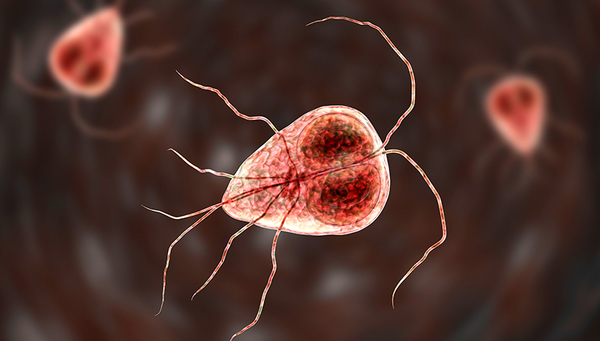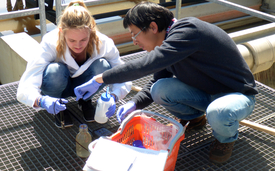Archive detail
Microbial cleaning crew scours sewage plants
March 7, 2022 |
Ciliates and rotifers are the ‘cleaners’ in sewage treatment plants. That is the result of a study by Jule Freudenthal and Kenneth Dumack from the University of Cologne’s Institute of Zoology, together with their Swiss colleagues Feng Ju and Helmut Bürgmann from the aquatic research institute Eawag. Ciliates and rotifers hunt pathogens like Giardia or Entamoeba, parasites that can befall the intestines of humans and animals. The researchers analysed DNA and RNA in wastewater and conducted network analyses of the microbial communities. The results of their work have been published in the article ‘Microeukaryotic gut parasites in wastewater treatment plants: diversity, activity, and removal’ in Microbiome.
The researchers gained new insights into one of the most important, but little studied functions of wastewater treatment plants: the removal of parasites. Sewage plants have complex communities of microorganisms consisting of beneficial water purifiers, but also harmful parasites that are washed in by our wastewater. Although it is generally known that sewage treatment plants work well, we still know surprisingly little about how they function. In particular, the fate of intestinal parasites during wastewater treatment has hardly been researched. The study can thus help to avoid public health risks in the future.
Eawag researcher Feng Ju and intern Sina Hasler taking samples at a wastewater treatment plant.
(Photo: Karin Beck)
Using DNA and RNA data collected in sewage treatment plants, the team discovered a surprising diversity of existing (DNA) and also active (RNA) parasites in the influent of the plants. They also found a large proportion of so-called ‘complex unicellular organisms’: protists such as Giardia, which causes giardiasis, an infection of the small intestine, or Entamoeba, which causes amoebic dysentery. They also found Blastocystis, an intestinal parasite that is common around the world. ‘We were able to confirm that the parasites are reduced during wastewater treatment, and attribute this to predator–prey interactions in the bioreactors,’ said doctoral researcher Jule Freudenthal, the lead author of the study.
The research further shows impressive activity by Rosculus, a small amoeba known mainly for multiplying explosively in cow dung. ‘We showed that this is also applies to the influent of wastewater treatment plants,’ said study leader Dr Kenneth Dumack. So-called network analyses, which show how microorganisms occur in relation to each other, also showed that ciliates and rotifers are important ‘cleaners’ that rid sewage water of parasites and thus enable the safe use of treated water.
Full monitoring and research into the mechanisms that reduce parasites in wastewater treatment plants will help to optimize the treatment process. Future research incorporating both DNA and RNA data can thus help reduce the public health risks associated with inadequately treated wastewater.
The original article comes from the University of Cologne: Microbial cleaning crew scours sewage plants.
Cover picture: Intestinal parasites like Giardia (pictured) enter sewage treatment plants via wastewater. (Photo: istock)
Original publication
Cooperations
Institute of Zoology, University of Cologne


